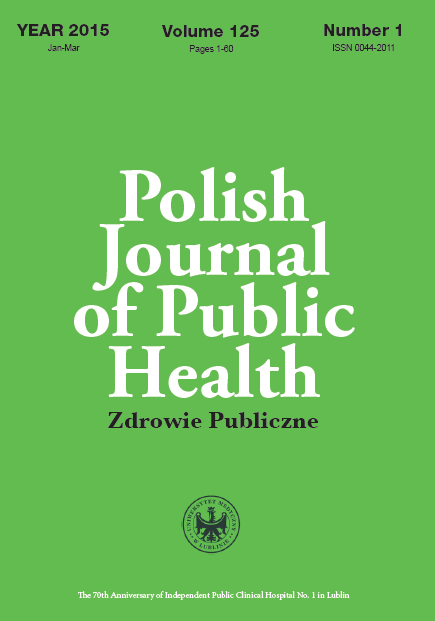Chromosomal abnormalities in a decade of prenatal testing at the Department of Obstetrics and Pathology of Pregnancy Medical University of Lublin
DOI:
https://doi.org/10.1515/pjph-2015-0018Keywords:
pregnancy, amniocentesis, screening test, Down Syndrome, chromosomesAbstract
Introduction. Chromosomal abnormalities, one of the leading causes of pregnancy complications, attract attention of both researchers and clinicians. They use two approaches to identify chromosomal abnormalities, namely screening and diagnostic tests. Ultrasonography is a very reliable screening and diagnostic tool, but the only way to determine if there are any chromosomal defects in the fetus, is performing one of invasive diagnostics tests chorionic villus sampling (CVS), cordocentesis or amniocentesis. Unfortunately, these invasive diagnostic procedures carry a potentially high risk of complications. Using amniocentesis means a procedure-related miscarriage risk at a rate of about 0.5-1%.
Aim. The aim of this paper was to present our own experience, results in performing amniocentesis and a review of the literature.
Material and methods. During a 10-year period 237 mid-trimester, transabdominal amniocenteses were performed.
Results. The follow-up revealed one spontaneous abortion within seven days after the procedure. Premature delivery occurred in fourteen cases (two of them with chromosomal abnormalities). No neonatal deaths related to amniocentesis were noticed. Chromosomal abnormalities were detected in 33 patients.
Conclusions. In the group with chromosomal abnormalities the main indications to perform amniocentesis were: improper ultrasound scan and the first trimester biochemical, noninvasive screening tests. This is a proof that modern, non-invasive procedures like the first-trimester ultrasound scan and biochemical tests should be made available to every pregnant woman and not only to mothers’ aged >35 years or those with a poor obstetrics history.
References
1. Copel JA, Bahado-Singh RO. Prenatal screening for down’s syndrome a search for the family’s values. N Engl J Med. 1999;341(7):521-2.
2. Cleary-Goldman J, Morgan MA, Malone FD, et al. Screening for down syndrome: Practice patterns and knowledge of obstetricians and gynecologists. Obstet Gynecol. 2006;107:11-7.
3. Kuppermann M, Norton ME. Prenatal testing guidelines: Time for a new approach. Gynecol Obstet Invest. 2005;60:6-10.
4. Nicolaides KH, Sebire NJ, Snijders RJ. Down’s syndrome screening with nuchal translucency. Lancet. 1997;349:438.
5. Larion S, Warsof SL, Romary L, et al. Association of combined firsttrimester screen and noninvasive prenatal testing on diagnostic procedures. Obstet Gynecol. 2014;123(6):1303-10. [Web of Science]
6. Lau GW, Feldman DS, Morales CM, et al. First-trimester aneuploidy screening: is there a maternal age at which it loses effectiveness? J Reprod Med. 2014;59(9-10):443-7.
7. Schmidt W, Gabelmann J, Muller U, et al. Genetic amniocentesis: Technique and results in 1,000 first trimester amniocenteses. Geburtshilfe Frauenheilkd. 1980;40:761-8.
8. Weise W, Gabriel D. Report Of 8 years’ experience in the prenatal diagnosis of genetic defects. Results. Zentralbl Gynakol. 1984;106:216-29.
9. Zergollern L, Lasan R, Relja Z. The usefulness of the chorionic villi technic in prenatal diagnosis. Jugosl Ginekol Perinatol. 1989;29:50-4.
10. Zolotukhina TV, Kuznetsov MI, Kostiuk EV, et al. Detection of chromosomal abnormalities using cordocentesis. Genetika. 1991;27:1481-5.
11. Lo YM, Corbetta N, Chamberlain P, et al. Presence of fetal DNA in maternal plasma and serum. Lancet. 1997;350:485-7.
12. Lenke RR, Ashwood ER, Cyr DR, et al. Genetic amniocentesis: Significance of intraamniotic bleeding and placental location. Obstet Gynecol. 1985;65:798-801.
13. Cunningham FG, Leveno KL, Bloom SL, et al. Williams Obstetrics, NY: Mcgraw-Hill; 2005. p. 328-30.
14. Jenkins TM, Wapner RJ, Khalek N. Prenatal diagnosis of congenital disorders. Maternal-Fetal Medicine: Principles and Practice; 2004. p. 263-9.
15. Nicolaides KH. Cordocentesis. Clin Obstet Gynecol. 1988;31:123-35.
16. Nicolaides KH, Rodeck CH. Fetal blood sampling. Baillieres Clin Obstet Gynaecol. 1987;1:623-48.
17. Canadian Early and Mid-Trimester Amniocentesis Trial (CEMAT) Group. Randomised trial to assess safety and fetal outcome of early and midtrimester amniocentesis. Lancet. 1998;351:242-7.
18. Nicolaides KH, Brizot M De L, Patel F, Snijders R. Comparison of chorionic villus sampling and amniocentesis for fetal karyotyping at 10-13 weeks’ gestation. Lancet. 1994;344:435-9.
19. Cruz-Lemini M, Parra-Saavedra M, Borobio V, et al. How to perform an amniocentesis. Ultrasound Obstet Gynecol. 2014;44(6):727-31. [Web of Science] [CrossRef]
20. Antsaklis A, Papantoniou N, Xygakis A, et al. Genetic amniocentesis in women 20-34 years old: associated risks. Prenat Diagn. 2000;20:247-50. [CrossRef] [PubMed]
21. Comas C, Echevarria M, Rodríguez I, et al. Prenatal invasive testing: a 13-year single institution experience. J Matern Fetal Neonatal Med. 2014;27(12):1209-12. [Web of Science] [CrossRef]
22. Nicolaides KH, Chervenak FA, Mccullough LB, et al. Evidence-based obstetric ethics and informed decision-making by pregnant women about invasive diagnosis after first-trimester assessment of risk for trisomy 21. Am J Obste Gynecol. 2005;193:322-6.
Downloads
Published
Issue
Section
License
Copyright (c) 2015 Polish Journal of Public Health

This work is licensed under a Creative Commons Attribution-NonCommercial-NoDerivatives 3.0 Unported License.


